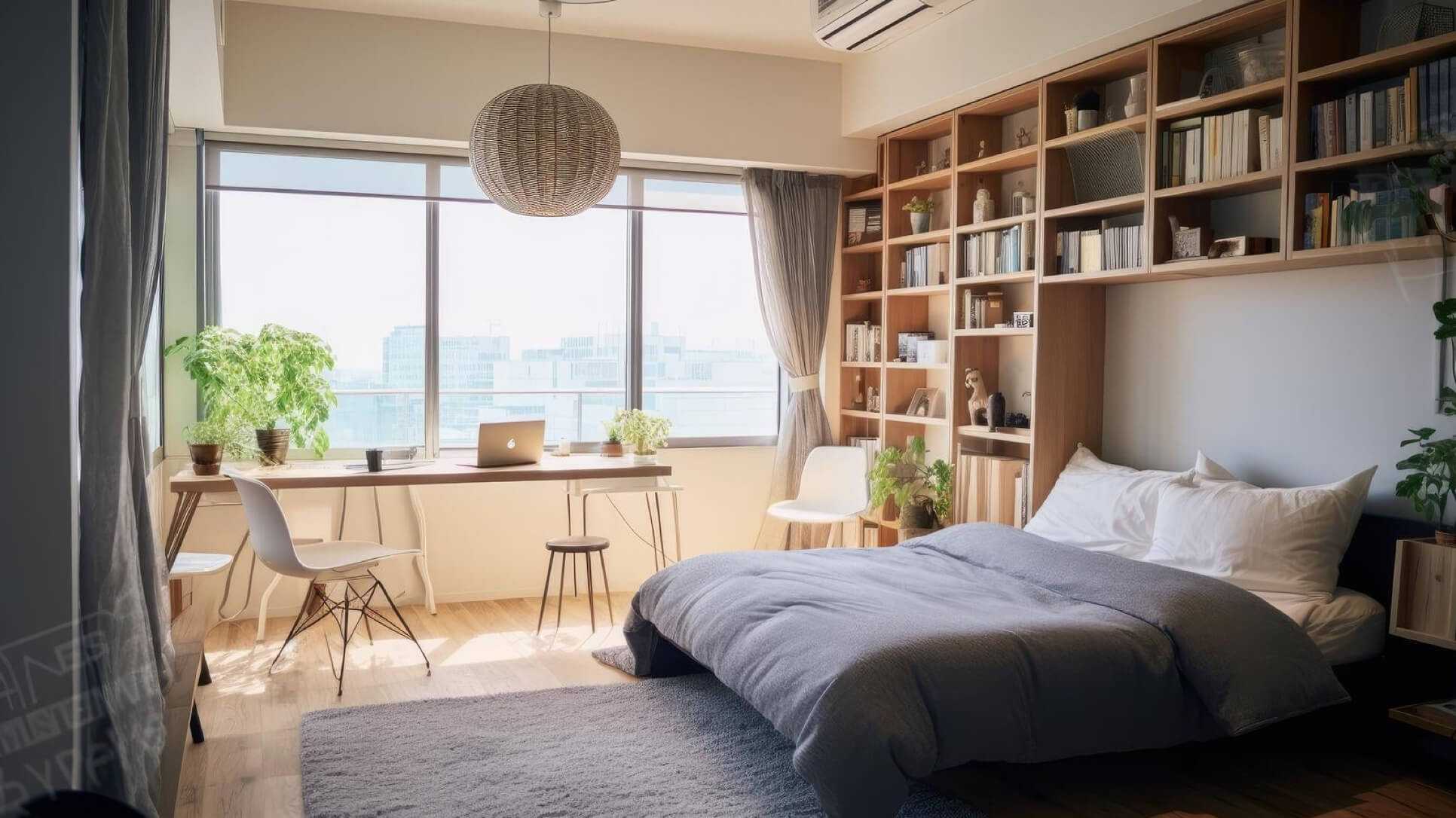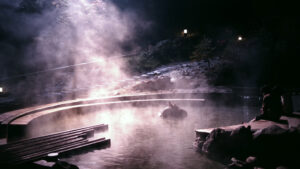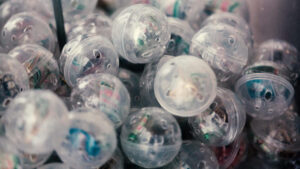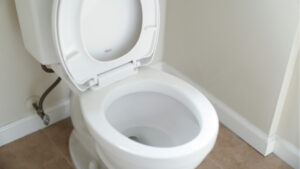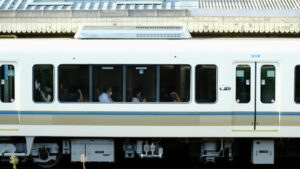Japanese rental apartments are compact yet highly functional, and they come with their own set of amenities, house rules, and neighborhood etiquette. This article explains how to read floor plans and understand building structures before you sign, how to use bathrooms, hot-water controls, and utilities right after moving in, and the everyday rules, shared-space manners, and ways to get along with neighbors that help you avoid trouble. Whether you’re relocating, studying abroad, or on a working holiday, this practical guide brings together everything you need so you won’t get stuck during your first week in a Japanese rental.
Contents
Basics of Japanese Apartment Amenities
Japanese rental apartments are fundamentally compact and functional. Air-conditioning (heating and cooling) is almost always standard; kitchens are either gas or IH (induction); there is typically an indoor washing-machine hookup (or one on the balcony), an intercom (video models are increasingly common), balcony drying brackets, and—mainly in condo-style buildings—parcel lockers. Bathrooms and toilets are either unitized or separate. Before you sign, be sure to check burner count and sink size, storage dimensions, curtain-rail width, outlet locations, mobile signal strength, sun exposure and afternoon western sun, and how much you can hear neighbors above, below, and next door.
Layouts and Building Types (Studio / 1K / 1DK · Wood / Steel / RC)
The naming depends on the number of rooms and the kitchen area. A studio (one-room) combines the living area and kitchen and is the most compact. A 1K has the kitchen separated from the living space by a door, which helps isolate smells and noise. 1DK/1LDK adds a dining (and living) area, giving more circulation space for working from home or for two people. As for structure: wood is light and breathable but tends to transmit sound; steel frame (S) resists vibration somewhat better; reinforced concrete (RC) is heavy and often superior for sound insulation and thermal performance—though windows, wall thickness, and build quality still matter. Choose the layout and structure together to fit your lifestyle (early riser, night owl, WFH) to avoid regrets.
How to Read Floor Plans and Size (Tatami “jo” and m²)
Listings show room size in square meters (m²) and often in tatami mats (jo). While it varies by region, a handy rule of thumb is 1 jo ≈ about 1.6 m² (~17 ft²). For example, 6 jo ≈ about 9.6 m²—enough for a single bed, a small desk, and a hanger rack without strain. The stated m² includes halls and storage, so two 25 m² units can feel different if the living room’s jo count is smaller. At viewings, bring the actual measurements of your furniture (bed width, desk depth) and use a tape measure to check curtain width, the refrigerator niche, and the washing-machine pan.
Sound and Insulation by Building Structure
As a rule, heavier materials perform better for noise and heat. Reinforced concrete (RC) typically has thicker walls and floors and transmits less sound from above, below, and next door. Steel-frame (S) resists vibration, but actual comfort depends on wall and floor build-up. Wood is light and breathes well but is more prone to footfall, voices, and plumbing noise. Comfort improves with double or low-E glazing, sound-damping flooring, and properly filled insulation. At viewings, ask whether windows are single or double glazed, where common corridors and pipe shafts run, and how thick the party wall is (e.g., number of gypsum boards); if possible, revisit at night to check everyday noise levels.
Pros and Cons by Floor (Ground / Middle / Top)
Ground floor: slightly cheaper rent, fewer stairs, easier moving; downsides include sightlines from passersby, damp and insects, and the need for extra security measures (shutters, window bars, cameras). Middle floors: often the best balance of sunlight, temperature, and noise with shorter elevator waits, but you may still hear neighbors above and below—check floor/ceiling sound insulation. Top floor: better views, more sun, and no upstairs noise; potential issues are summer heat from the roof, winter chill, lower water pressure, and wind or rain noise; without an elevator, consider daily climbing. For any floor, consider balcony orientation (strong western sun in summer), the position of emergency stairs, and distance to noise sources such as the trash area or roads to improve comfort after move-in.
Using Water, Hot Water, and the Bathroom
In many Japanese apartments, a water-heater controller in the kitchen or bathroom lets you set water temperature and auto-fill the tub. Bathrooms are typically unit baths (tub plus shower), and some buildings recommend running the exhaust fan on low 24/7. To prevent mold and scale, squeegee or wipe down the walls after bathing and ventilate longer; use a hair trap at the drain to avoid clogs. Note that older or smaller walk-up apartments may not have a controller—instead you may find a kitchen instant water heater, a bath unit with manual knobs only, or an electric storage heater.
Switching Between Shower and Spout, and Reheating
Shower/spout switch: Use the small lever or pull-rod to switch. Many mixers separate a thermostatic temperature dial and a flow lever. Start at lukewarm (about 38–40°C).
Auto fill: On the controller, use “Auto”/“Fill” to draw a fixed amount of bathwater; it beeps and stops automatically. Press “Stop/Cancel” to interrupt.
Reheating (oidaiki): If your tub has a circulation inlet, you can reheat cooled bathwater. Check the manual—sulfur-based bath additives are usually not allowed, and bathing right after hair dye or creating heavy foam can clog the filter.
High-temperature top-up: In non-reheat setups, add a little hot water and stir to raise the temperature gradually to avoid burns.
Water-saving & safety: Use the pause button on the shower head when soaping; enable the child lock if available for households with kids.
Washlet (Bidet Toilet Seat)
Note: Not all rental units in Japan come with a washlet (electric bidet seat). Name: “Washlet” is a TOTO trademark; the generic term is electric bidet seat (washlet). How to use: Use the remote’s Rear/Cleanse · Bidet · Stop buttons and adjust water pressure, nozzle position, and temperature—start weak and cool. Sensor: The spray will not operate unless the seat sensor detects you (it won’t spray while you’re standing). Energy-saving: Turn the power off or use Eco mode when away for long periods, and set seat heating to low or off.
Washing-Machine Hookups (Indoor/Balcony) and Drying Options
Measure before installation: the drain pan’s inner dimensions, faucet height, drain position (left/right/rear), and the path for bringing the unit in (door and hallway widths). Drum washers are large and heavy—confirm with the management company first.
Indoor setup: Use anti-vibration pads or risers to stabilize vibration and drainage. Even with “quiet” modes, avoid late-night operation. Clean the lint filter every load or every few loads.
Balcony setup: Requires a weatherproof outlet and outdoor-rated faucet. Use a waterproof cover against rain and sun. In winter, prevent freezing by draining hoses or adding insulation.
- Bathroom dryer: Hang laundry in the bathroom and run Dry/Vent modes for a few hours; clean the filter regularly to prevent mold.
- Indoor air-drying: Combine a dehumidifier with a circulator; alternate thick and thin items and keep about 10 cm of space from walls for airflow.
- Balcony drying: Secure items inward with pinch hangers to prevent drops; during pollen or yellow-dust seasons, limit outdoor drying.
- Laundromat: Large dryers are ideal for bedding and towels; use a laundry net for transport and follow the shop’s “no long-term leaving” rules.
Utilities (Electricity, Gas, Water, Internet)
In Japan, everyday “lifelines” are electricity, gas, water, and internet. In most rentals, tenants arrange the start/stop of these services themselves. Contact providers 3–7 days before moving for a smooth start. Some buildings post provider contacts in the move-in guide or on the notice board. Water is often on a building-wide contract included in rent or common charges; if so, applying via the management company is usually enough.
Contract Types (City Gas / Propane, Choosing an Electricity Provider)
- Gas (City gas / Propane): City gas (13A) is supplied via underground mains, common in urban areas with relatively stable pricing; opening the valve often requires a technician visit for safety checks. Propane (LP) comes from on-site tanks, common at smaller or suburban buildings and often pricier per unit. Appliance compatibility: stoves and water heaters are specific to gas type—confirm before moving.
- Electricity (provider & amperage): Japan uses AC 100V with Type-A plugs; frequency is 50 Hz in eastern Japan and 60 Hz in western Japan, and most appliances support both. Power retailing is liberalized, so you can choose a regional utility or an alternative supplier and plan. Your contracted amperage (A) affects the basic fee; 30–40 A suits most singles or couples. If the breaker trips when running a microwave and hair dryer together, consider increasing the amperage. Payment by bank debit or credit card is common; smart meters may allow activation without a visit.
- Water: Normally you apply to the municipal water bureau (many accept online applications). With a building-wide contract, charges may be flat or bundled into rent—confirm the start procedure with management.
Breaker Basics and What to Do During an Outage
Panel components: Main/contract breaker (trips if you exceed contracted amperage); earth-leakage breaker (ELB/GFCI; trips on leakage, has a TEST button); and branch breakers for individual circuits (kitchen, AC, lighting, etc.).
- First determine whether the outage affects the whole building or just your unit (check corridor lights or neighboring units).
- If it’s just your unit, open the panel.
- Turn all branch breakers OFF → switch the main breaker ON → turn branch breakers ON one by one to identify the culprit circuit.
- Reduce simultaneous use on that circuit (e.g., don’t run the microwave and hair dryer together) or consider increasing contracted amperage.
- If the ELB trips, or you notice burning smells or water around outlets, stop using the circuit and contact the management company immediately to prevent shock or fire.
Internet Connection Types (Fiber / CATV / Pocket Wi-Fi)
Fiber (FTTH / Optical)
The fastest and most stable option. A fiber line runs to your room and you use an ONU (optical network unit) plus a Wi-Fi router. Some buildings use VDSL (over telephone lines) or in-building LAN instead, which can reduce actual upload/download speeds compared with direct fiber. Installation typically takes about 1–2 weeks; if drilling or exterior work is required, obtain the owner’s approval first. Major providers include NTT (Flets and reseller “collab” services), au Hikari, and NURO; availability depends on the building, so check the supported services list.
CATV (Cable Internet)
Uses coaxial cable and is sometimes bundled with TV service. Speeds vary widely by plan and area, and large buildings can experience peak-time congestion.
Mobile (Pocket Wi-Fi / 5G Home Router)
No installation and can be used immediately, making it suitable for short stays or buildings that don’t allow construction. Check indoor signal strength, data caps and throttling policies, upload speed, and latency; if you do many video calls or streaming, run a speed test.
Building Shared Wi-Fi (Free or Flat-Fee)
Easy to start with no upfront cost, but performance may drop when many neighbors are online. Confirm security (WPA2 or higher) and any IPv4/IPv6 or NAT restrictions. For work use, check whether you can bring your own router and whether a wired LAN port is available.
House Rules and Manners
In Japanese apartment buildings, walls can be relatively thin and residents keep varied schedules, so small sounds and smells can easily cause disputes. Always check the bulletin board, your lease, and the building’s house rules first, and stick to three basics: keep nights quiet, don’t leave personal items in shared areas, and sort and dispose of trash according to local rules.
Consideration for Noise and Everyday Sounds
Common triggers for complaints include footsteps, door slams, water noise, appliance noise, voices, and low-frequency sound from instruments or TVs.
Quiet Hours and Footstep/Vibration Tips
Typical quiet hours: Many buildings use 22:00–07:00 (follow any posted or lease-specific rules). During these hours, avoid running the washing machine or vacuum, loud TV/music, and moving furniture. Late-night or early-morning balcony conversations and phone calls carry easily—avoid them.
- Lay a rug plus a thick underlay (non-slip/sound-damping), especially along walkways, around the bed, and in kids’ play areas.
- Add felt or rubber caps to chair and table legs; lift furniture to move it—don’t drag.
- Close doors gently; adjust the door closer speed or add bumpers to prevent slamming.
- Tighten bed frame screws and place anti-vibration pads under the legs.
- Prevent nighttime “drop” noises by keeping only light items on upper shelves.
Appliance Use Hours (Washer, Vacuum, etc.)
Suggested hours (building rules take priority):
- Washing machine: 08:00–20:00. Spin cycles cause the most vibration; use anti-vibration pads or risers.
- Vacuum cleaner: 09:00–19:00. At night, switch to a floor wiper or mop.
- Hair dryer / blender / power tools: Keep use brief and avoid after 22:00.
- Bathroom fan / bath reheating: Limit continuous late-night operation—mechanical and pipe noise can carry.
Quiet-operation tips:
- Use “quiet” or “night” modes when available.
- Redistribute laundry to prevent drum imbalance and noisy spin cycles.
- Level refrigerators and washers; wobble causes resonance.
- Disable device beeps/alerts in settings if possible.
Volume Management for Instruments, Parties, and Guests
Instruments: Many leases or building notices restrict or prohibit practice—check first. If allowed, keep it to about an hour in daytime, close windows, use mutes/dampers, and use headphones with electronic instruments. If you practice regularly, consider a rental studio.
Parties/guests: Keep groups small and wrap up by ~21:00–22:00. No conversations or smoking on balconies or in corridors. Bass travels easily, so keep music low. On the rare occasions you host, recheck building rules in advance and be considerate about door openings and carrying trash back to your unit.
Trash Disposal and Recycling Rules
Rules differ by municipality in Japan, so always check the trash calendar (paper/PDF) provided at move-in, the building notice board, or your management company’s guide. If your building has a shared trash area (trash station/room), follow the posted instructions for pickup days, time windows, sorting, and how to use the anti-bird net. Many areas require designated bags and proper netting.
Separation Basics (Burnable / Non-burnable / Recyclables)
Names and categories vary by city; the following is a general guide.
- Burnable (combustible): Kitchen waste, paper scraps, tissues, small wood/leather pieces, small amounts of clothing. Tips: Drain moisture; wrap strong-smelling waste in newspaper. Do not include: batteries, spray cans, lighters (these are hazardous). For used oil, solidify or absorb with paper before sealing.
- Non-burnable: Broken glass/ceramics, small metal items, the bodies of small appliances (remove batteries). Tips: Wrap sharps in thick paper and mark “Danger.” Do not include: the four designated appliances (TV, air conditioner, refrigerator/freezer, washer/dryer) or personal computers (these use special routes).
- Recyclables: Bottles/cans: Rinse lightly; sort bottle colors if instructed. PET bottles: Remove caps and labels; crush if requested. Paper: Tie newspapers, magazines, cardboard, and cartons separately with string; cartons are usually “white-lined only”—rinse, open, and dry. Plastic packaging (by city): Items with the “プラ” symbol such as trays, bags, and cups; rinse lightly—if residue won’t come off, dispose as burnable.
- Hazardous/controlled items: Dry cells, button/rechargeable batteries, fluorescent tubes, mercury thermometers, lighters, spray cans. Use designated collection days or boxes. Empty spray cans completely and follow your city’s instructions on puncturing.
Collection Days, Put-Out Times, and Designated Bags
Collection days are fixed by municipality and neighborhood (e.g., burnables on Mon/Thu, recyclables on the 2nd & 4th Tue). As a rule, set trash out on the morning of pickup (e.g., by 08:00). Many areas ban putting trash out the night before; if allowed, follow the specified window (e.g., 20:00–22:00). Confirm the location and open hours of your building’s shared trash area; do not leave personal items or bulky waste there temporarily.
Designated bags: Many cities require designated transparent or semi-transparent colored bags, priced by size (S/M/L). In general, opaque black bags are not allowed. Tie bags tightly and avoid overfilling, which can cause tearing.
Odor & pest tips: Strain kitchen waste; freezing food scraps and taking them out on collection day works well. Solidify cooking oil or line a milk carton with newspaper to absorb and seal. For crow protection, place bags under the net and consider double-bagging.
Bulky Waste and Appliance Recycling Procedures
Bulky waste (furniture, bedding, large items)
Rule of thumb: items with any side about 30–50 cm or longer (varies by city). Typical steps: (1) Apply via phone/website with item and size to receive a pickup date and fee. (2) Buy a bulky-waste sticker at a convenience store, write your name and reference number, and attach it. (3) Place the item at the specified spot/time (usually outdoors/ground floor; indoor carry-out is generally not included). Some cities offer cheaper drop-off at a facility. Consider reuse options (flea-market apps, donation, recycle shops) for items in good condition.
Home Appliance Recycling Law (4 categories)
TVs, air conditioners, refrigerators/freezers, and washing machines/dryers are not collected by regular municipal pickup. For replacement, ask the retailer to take the old unit (recycling fee plus transport). For disposal only, purchase a recycling ticket at the post office and take the unit to a designated site yourself, or arrange pickup with a retailer/hauler. Fees vary by maker and capacity—check estimates online in advance.
PC Recycling Law
PCs with the “PC Recycling” mark are collected by the manufacturer (fee included). Without the mark, paid collection is typical. Apply to the manufacturer, ship using the provided label, and be sure to erase data yourself.
Small appliance recycling
Smartphones, tablets, digital cameras, and cables can be dropped in collection boxes at municipal offices or electronics stores. Always initialize devices and remove personal data.
Entrances, corridors, stairs, balconies, bike parking, and trash areas are shared by all residents. The golden rule is “don’t leave items, don’t block passage, don’t make a mess.” Follow posted notices and house rules first. For fire-safety and evacuation reasons, many buildings prohibit keeping belongings in corridors or on balconies.
Do Not Leave Items by Your Door, in Hallways, or on Balconies
- Entryway & shared corridors: Keeping doormats, umbrella stands, strollers, or cardboard boxes there is generally prohibited because they hinder evacuation, cleaning, and passage. Don’t charge devices from shared outlets without permission (fire/electric-shock risk). Close doors quietly and bring parcels inside promptly.
- Balconies: Often treated as evacuation routes; no large storage, bicycles, BBQ gear, or flammables. Keep planters on the inside with saucers so water/soil won’t drop to lower floors; bring laundry indoors on windy days. Smoke and odors from smoking, BBQ, or incense cause disputes, and many buildings ban balcony smoking. Mounting satellite dishes, etc., typically requires approval—no drilling into exterior walls or railings.
Parcel Lockers, Mail, and Notice Board Etiquette
- Parcel lockers: Make the delivery name match your mailbox label (English name + room number recommended). Perishables and chilled items are not allowed; collect within the stated period (e.g., 1–3 days). In auto-lock buildings, “leave at door” (置き配) may be restricted—check app settings and building rules. Oversized items usually can’t be held by staff; request redelivery.
- Mailboxes: Write your address correctly in Japanese and roman letters with building and unit numbers. Update the label if your surname changes or you add a housemate; many residents choose not to display a nameplate for privacy. If you receive someone else’s mail, return it to sender or inform management—don’t discard it.
- Notice boards: Important updates (trash-day changes, water shutoffs, inspections, cleaning schedules) appear here—make a habit of checking. Personal postings typically require permission; don’t post on your own or remove flyers unless authorized.
Rules for Bike Parking, Car Parking, and the Shared Trash Area
Bike Parking (Bicycles & Motorbikes)
- Registration and a permit sticker are required in many buildings; abandoned vehicles may be removed.
- No temporary parking in corridors, on stairs, or in front of entrances. Move bikes quietly; no idling or revving at night (motorbikes).
- Complete anti-theft registration and use locks. Check whether spaces are roofed or exposed to rain.
- Charge e-bikes indoors; using shared outlets in common areas is generally prohibited.
Car Parking
- Only your contracted vehicle may use your numbered space; direct visitors to coin-operated lots.
- For mechanical (tower) parking, follow limits on size, weight, and minimum ground clearance; roof boxes or aero parts may prevent entry.
- No engine revving, prolonged idling, or loud audio; be mindful of door noise early in the morning and late at night.
Shared Trash Area
- Follow sorting rules, collection days, and time windows; comply with any “no night-before” notices.
- Flatten and tie cardboard; rinse cans and bottles before disposal.
- If the area is full, don’t pile items—contact management. Clean up any leaks or torn bags yourself.
- Replace nets and lids after use; lock the trash room if it is key-controlled.
Tips for Getting Along with Neighbors
In Japanese apartment living, the norm is to maintain a comfortable, polite distance. You don’t need to force deep interaction; a brief nod or greeting when you pass is enough. If issues arise, avoid direct confrontation and consult the management company first. Get into the habit of checking the notice board and house rules regularly, and be mindful of noise, smells, and how you use shared areas.
Greetings When Moving In and Day to Day
These days, especially among single tenants, many do not do door-to-door greetings after moving in, often for safety and privacy (not revealing gender or routine, uncertainty about neighbors’ schedules). The modern, low-risk default is simply to be pleasant when you meet—a quick hello in the corridor or elevator is sufficient.
Basics of Preventing and Resolving Conflicts
Small courtesies prevent problems; if something does happen, prioritize procedure over emotion. Start by confirming the rules, then check whether anything on your side is contributing, keep a simple record of dates and times, and contact the management company. Avoid direct complaints or posting notes on a neighbor’s door; proceed anonymously and stick to the facts.
Consideration for Odors, Smoke, Pets, and Balcony Smoking
Odors & smoke (non-tobacco: cooking, incense, detergents):
- Use strong ventilation when cooking (high fan + crack a window); use lids/splatter screens to contain oil.
- Drain and seal food waste; take it out on collection morning. Clean drains regularly.
- Keep strong incense/aroma to a minimum at night and avoid using them near windows.
- Highly scented detergents/softeners spread indoors when air-drying—use less and ventilate.
Tobacco (especially balcony smoking): Many buildings ban or discourage balcony smoking (evacuation route, odors, fire risk). Even if allowed, avoid smoking near windows, prevent ash scatter, deodorize, and avoid late-night smoking. Open flames on balconies (charcoal, cassette stoves) are generally prohibited.
Pets (in pet-friendly buildings):
- Carry pets or use a carrier in common areas; clean any accidents or fur immediately.
- Reduce barking/running noise with exercise, training, and sound-damping mats.
- Use a covered litter box with deodorizer; do not place pet toilets on the balcony.
- Prevent escapes (screen-lock, ID tags) and trim nails to avoid floor/wall damage.
Consulting the Management Company Before Contacting a Neighbor
- Organize facts: Note what happened, when/how often, from which direction (up/down/side), and how long/impact on life. If possible, keep objective records (times when noise/odor was strongest). Avoid filming individuals.
- Confirm the rules: Check your lease, move-in guide, and notices for clauses on smoking, noise, pets, and common areas; note clause names/pages.
- Self-check: Review your own potential causes (exhaust direction, appliance vibration, floor resonance, strong fragrances) and adjust what you can.
- Contact management (email preferred): Report the situation factually and request an anonymous notice or guidance rather than naming a specific unit.
The Three Essentials: Pre-Checks, Quiet-Living Habits, and Consulting Management
To start life in a Japanese apartment smoothly, focus on three points: (1) take measurements and verify equipment before moving in (layout, sound insulation, internet type, gas type); (2) practice noise-aware habits—mind hours and vibration for laundry, cleaning, footsteps, and balcony use; and (3) when issues arise, consult the management company instead of confronting neighbors directly. Keep these checkpoints in mind to stay comfortable from day one and for the long haul.
